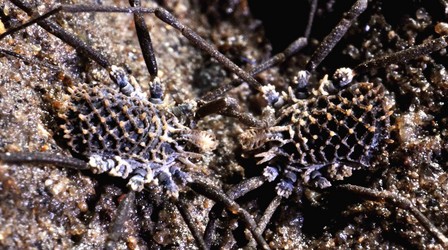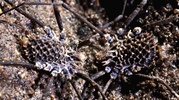Nemastomatidae
Axel Schönhofer


This tree diagram shows the relationships between several groups of organisms.
The root of the current tree connects the organisms featured in this tree to their containing group and the rest of the Tree of Life. The basal branching point in the tree represents the ancestor of the other groups in the tree. This ancestor diversified over time into several descendent subgroups, which are represented as internal nodes and terminal taxa to the right.

You can click on the root to travel down the Tree of Life all the way to the root of all Life, and you can click on the names of descendent subgroups to travel up the Tree of Life all the way to individual species.
For more information on ToL tree formatting, please see Interpreting the Tree or Classification. To learn more about phylogenetic trees, please visit our Phylogenetic Biology pages.
close boxIntroduction
Nemastomatidae represents the most diverse family of the Dyspnoi, contributing more than half the genera and about a third of the species. They are very small to medium sized harvestmen with a disjunct Holarctic distribution. The center of diversity is the Western Palearctic, where most genera and species of the Nemastomatinae occur that often reach high population densities. The subfamily is also present in Asia. The second subfamily, Ortholasmatinae, has the most described species in Central America and along the Western Coast of North America. Two species occur in isolated localities in Asia.
Prominent features of Nemastomatidae are the complex club-shaped hairs on the palps, whose function is still speculative (Wachmann 1970). These hairs can be found in juveniles of other Troguloidea, but in Nemastomatidae they are prominent in all stages of live. The translated scientific name “thread-mouth” likely refers to the palps being covered with these conspicuous hairs (Simon 1872). Other features of the family are unique male genital morphological traits within the Dyspnoi: unlike other Troguloidea, the glans is not movable against the truncus and the slender truncus cane is probably deformed as a whole when the muscles are contracted. The muscles are concentrated in the bulblike base of the penis and muscular tendons connect muscles and the distal part of the truncus (except for Mitostoma). The mechanical stress applied to the distal part of the penis leads to the development of exotic wing like stabilizing structures (Martens 2011, Schönhofer and Martens 2012). Many Nemastomatidae show rich and elaborate ornamentation of the dorsal body, with rows of spines, elevated cones, bridge-thorns and/or triangular intersecting thorns, forming distinct patterns that are species- or even group- specific.
Taxonomy and Discussion of Phylogenetic Relationships
Efforts to organize the diversity within Nemastomatidae started relatively late with Roewer (1951) and Kratochvíl (1958). Since then, taxonomy moved from applying exclusively external morphological characters towards an elaborate systematic interpreting male genital morphological functionalities and male cheliceral apophyses and glands (started by ilhavý 1966, summarized in Schönhofer and Martens 2012). New genera and species are still described on a regular basis, suggesting research to be necessary in many geographic areas, especially in Asia (Martens 2006, Snegovaya 2010, Schönhofer and Martens 2012) and Central America (Shear 2006, 2010).
References
Kratochvíl, J. 1958. Höhlenweberknechte Bulgariens (Palpatores - Nemastomatidae). Práce Brněnské základny Československé akademie věd 30(12):523-576.
Martens, J. 2006. Weberknechte aus dem Kaukasus (Arachnida, Opiliones, Nemastomatidae), Senckenbergiana biologica 86(2):145-210.
Martens, J. 2011. The Centetostoma scabriculum complex - a group of three cryptic species (Arachnida: Opiliones: Nemastomatidae). Zootaxa 2783:35-51.
Roewer, C. F. 1951. Über Nemastomatiden. Weitere Weberknechte XVI. Senckenbergiana 32:95-153.
Schönhofer, A.L. and J. Martens. 2012. The enigmatic Alpine opilionid Saccarella schilleri gen. n., sp. n. (Arachnida: Nemastomatidae) - isolated systematic placement inferred from comparative genital morphology. Organisms Diversity and Evolution (online).
Shear, W. A. 2006. Martensolasma jocheni, a new genus and species of harvestman from Mexico (Opiliones: Nemastomatidae: Ortholasmatinae). Zootaxa 1325:191-198.
Shear, W. A. 2010. New species and records of ortholasmatine harvestmen from México, Honduras, and the western United States (Opiliones, Nemastomatidae, Ortholasmatinae). ZooKeys, 52:9-45.
ilhavý, V. 1966. Über die Genitalmorphologie der Nemastomatidae (Arach., Opiliones). Senckenbergiana biologica 47:67-72.
Simon, E. 1872. Notices sur les arachnides cavernicoles et hypogés. Annales de la Société Entomologique de France 5(2):214-244.
Snegovaya, N. Y. 2005. New Harvestman Genus and Species from Kyrgyz Republic (Kyrgyzstan) (Arachnida: Opiliones: Nemastomatidae). Acta Zoologica Bulgarica 62(3):351-354.
Wachmann, E. 1970. Der Feinbau der sog. Kugelhaare der Fadenkanker (Opiliones, Nemastomatidae). Zeitschrift für Zellforschung 103:518-525.
Title Illustrations

| Scientific Name | Mitostoma chrysomelas |
|---|---|
| Specimen Condition | Live Specimen |
| Identified By | Axel Schönhofer |
| Sex | Female |
| Source | Picasa - My Harvestmen Pics |
| Copyright |
© 2009 Axel Schönhofer

|
| Scientific Name | Ortholasma coronadense |
|---|---|
| Specimen Condition | Live Specimen |
| Identified By | Axel Sch?nhofer |
| Life Cycle Stage | adult |
| Copyright |
© 2011 Axel Schönhofer

|
About This Page
Many thanks to Angela DiDomenico for the final English check.
Axel Schönhofer

San Diego States University, San Diego, California, USA
Correspondence regarding this page should be directed to Axel Schönhofer at
Page copyright © 2013 Axel Schönhofer
 Page: Tree of Life
Nemastomatidae .
Authored by
Axel Schönhofer .
The TEXT of this page is licensed under the
Creative Commons Attribution-NonCommercial License - Version 3.0. Note that images and other media
featured on this page are each governed by their own license, and they may or may not be available
for reuse. Click on an image or a media link to access the media data window, which provides the
relevant licensing information. For the general terms and conditions of ToL material reuse and
redistribution, please see the Tree of Life Copyright
Policies.
Page: Tree of Life
Nemastomatidae .
Authored by
Axel Schönhofer .
The TEXT of this page is licensed under the
Creative Commons Attribution-NonCommercial License - Version 3.0. Note that images and other media
featured on this page are each governed by their own license, and they may or may not be available
for reuse. Click on an image or a media link to access the media data window, which provides the
relevant licensing information. For the general terms and conditions of ToL material reuse and
redistribution, please see the Tree of Life Copyright
Policies.
- First online 03 April 2013
- Content changed 03 April 2013
Citing this page:
Schönhofer , Axel. 2013. Nemastomatidae . Version 03 April 2013 (under construction). http://tolweb.org/Nemastomatidae/60691/2013.04.03 in The Tree of Life Web Project, http://tolweb.org/




.250a.jpg)

.100a.jpg)


 Go to quick links
Go to quick search
Go to navigation for this section of the ToL site
Go to detailed links for the ToL site
Go to quick links
Go to quick search
Go to navigation for this section of the ToL site
Go to detailed links for the ToL site